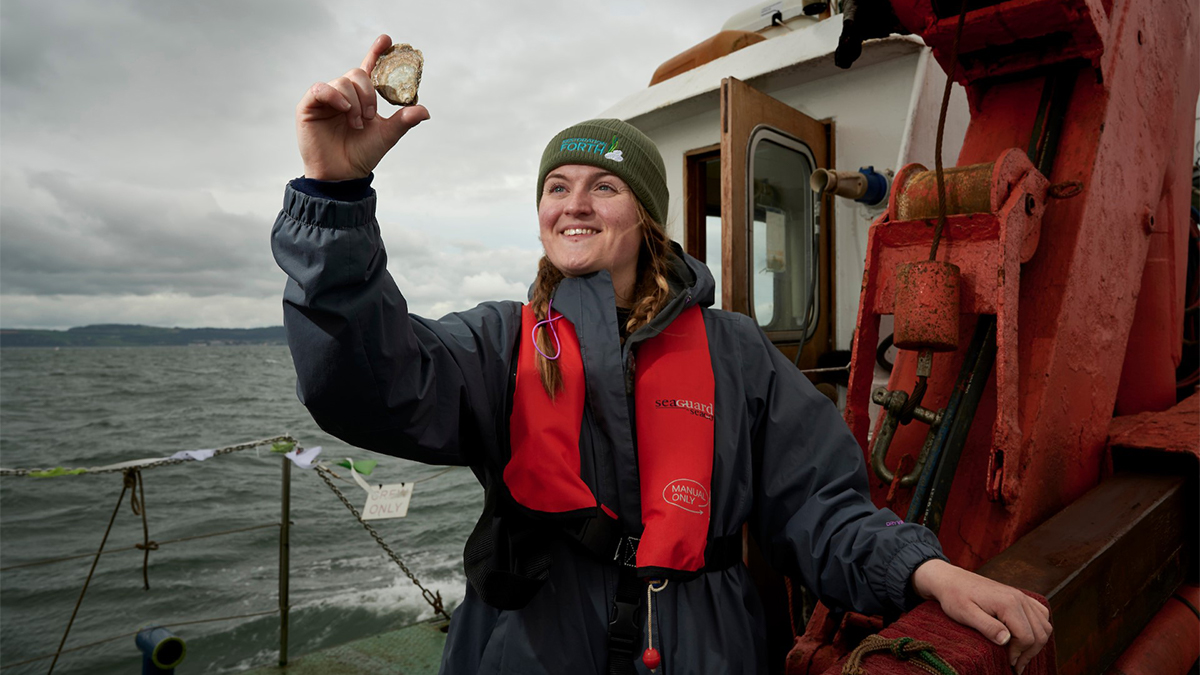Published:

For the first time in 100 years, native oysters have been returned to the Firth of Forth as part of the groundbreaking “Restoration Forth” project.
Historically, enormous native oyster beds provided an important source for food and livelihoods in the area before they were lost due to overfishing and industrial development.
With wrap-around scientific support from Heriot-Watt University, 30,000 oysters will eventually be reintroduced over the project's lifetime to create a new oyster reef in the famous estuary, providing a vital habitat for many other species including fish, crabs, sea snails and sponges.
This is a historic milestone which deserves celebration as this important native species returns to the Firth of Forth.
The oysters will also filter water and improve water clarity, meaning more light can penetrate through to the seabed, allowing plants like seagrass to photosynthesise and grow. The native oysters being introduced to the Firth of Forth were sourced and supplied from Little Loch Broom and treated onsite to adhere to stringent biosecurity protocols before deployment.
Emmy Cooper-Young from Heriot-Watt University has been instrumental in researching and identifying the sites for restoration in the Firth of Forth. She said: “This is a historic milestone which deserves celebration as this important native species returns to the Firth of Forth. We're proud that Heriot-Watt University has provided wide-ranging support for this project from its early days.
"We have utilised our expertise in marine restoration and taken learning from our other projects to identify suitable sites in which to reintroduce the oysters, alongside guidance on licensing and monitoring, biosecurity training and supply chain management. We've been supported by an army of volunteers and university support staff to successfully reach this point.”
Following the release of the first oysters into the Forth on Monday 18th September, Professor Bill Sanderson, a leading expert and professor in marine biodiversity at Heriot-Watt University's School of Energy, Geoscience, Infrastructure and Society, reflected: "There are people in the communities around the Firth of Forth who will have heard their grandparents remember the oysters. Now it could be our grandchildren that will see these populations recovered to their former glory. There was once an oyster bed in the Firth of Forth the size of the present-day city of Edinburgh."
Caitlin Godfrey, Shellfish Engagement Officer at Marine Conservation Society said: “It's so exciting that the first native oysters are now in their new home in the Firth of Forth. Alongside seagrass meadows, they will play a crucial role in bringing the estuary back to life and transforming the future of this coastal environment for people and nature. We couldn't have come this far with the project without the support of local communities.”
Bill Simpson, Skipper of the Conserver boat said: “I've been working on the Forth for over 50 years and have read and heard stories of oysters and Newhaven fishermen. It's good to know we will have oysters back – let's hope they go forth and multiply.”
Màiri McAllan, Cabinet Secretary for Transport, Net Zero, and Just Transition said: “I'm honoured and delighted to have been part of Restoration Forth's historic event, returning native oysters to the Firth of Forth for the first time in around 100 years.
"Communities in Scotland are, as they should be, at the forefront of our nature restoration efforts, and it has been very encouraging to see the drive and enthusiasm of people involved in this project to take action to restore and protect their local marine environment. In the midst of a nature and climate crisis, we all have a responsibility to support the recovery of our natural environment. The Scottish Government is committed to working with communities to promote nature restoration across the country, and I look forward to seeing many more projects following Restoration Forth's example.”
Earlier this year, the first seeding of seagrass was successfully carried out in three locations along the Firth of Forth coast. Successful germination has taken place, as green shoots are now appearing with species such as juvenile flatfish already using the young plants as a nursery.
Partners delivering Restoration Forth include WWF, Heriot-Watt University, Marine Conservation Society, Edinburgh Shoreline, Fife Coast & Countryside Trust, Project Seagrass, Royal Botanic Garden Edinburgh, Scottish Seabird Centre, The Ecology Centre and The Heart of Newhaven Community.
Restoration Forth is funded by Aviva, the ScottishPower Foundation, and the Moondance Foundation; this project is also supported by the Scottish Government's Nature Restoration Fund, through Scottish Marine Environmental Enhancement Fund (SMEEF) facilitated grants.